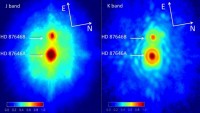VLT in Chile to Search for Exoplanets in Alpha Centauri with Breakthrough Initiatives Assistance
| Arthur Dominic Villasanta | | Jan 09, 2017 10:12 PM EST |
(Photo : ESO) ESO's VLT facility in Chile.
The European Space Organization (ESO) has signed an agreement with the Breakthrough Initiatives to adapt the Very Large Telescope instrumentation in Paranal, Chile to conduct a search for exoplanets in the nearby star system of Alpha Centauri.
These exoplanets could be the targets for an eventual launch of miniature space probes by the Breakthrough Starshot initiative.
Like Us on Facebook
The agreement provides funds for the VISIR (VLT Imager and Spectrometer for mid-Infrared) instrument mounted at ESO's Very Large Telescope (VLT) to be modified in order to greatly enhance its ability to search for potentially habitable planets around Alpha Centauri, the closest stellar system to the Earth.
It also provides for telescope time to allow a careful search program to be conducted in 2019.
The agreement was signed by ESO Director General Tim de Zeeuw Breakthrough Initiatives and Pete Worden, Chairman of the Breakthrough Prize Foundation and Executive Director of the Breakthrough Initiatives.
At Paranal, ESO operates the Very Large Telescope, the world's most advanced visible-light astronomical observatory, and two survey telescopes.
There are sound reasons for focusing on Alpha Centauri. The discovery in 2016 of a planet, Proxima b, around Proxima Centauri, the third and faintest star of the Alpha Centauri system, adds even further impetus to this search.
Knowing where the nearest exoplanets are is of paramount interest for Breakthrough Starshot, the research and engineering program launched in April 2016.
Breakthrough Starshot aims to demonstrate proof of concept for ultra-fast light-driven "nanocraft," laying the foundation for the first launch to Alpha Centauri within a generation.
Detecting a habitable planet in Alpha Centauri is an enormous challenge given the brightness of the planetary system's host star, which tends to overwhelm the relatively dim planets.
It is easier to observe Alpha Centauri in the mid-infrared wavelength range where the thermal glow from an orbiting planet greatly reduces the brightness gap between it and its host star. But even in the mid-infrared, the star remains millions of times brighter than the planets to be detected, which calls for a dedicated technique to reduce the blinding stellar light.
The existing mid-infrared instrument VISIR on the VLT will provide this performance if it were enhanced to greatly improve the image quality using adaptive optics, and adapted to employ a technique called coronagraphy to reduce the stellar light and thereby reveal the possible signal of potential terrestrial planets.
Breakthrough Initiatives will pay for a large fraction of the necessary technologies and development costs for such an experiment, and ESO will provide the required observing capabilities and time.
The new hardware includes an instrument module contracted to Kampf Telescope Optics (KTO), Munich, which will host the wavefront sensor, and a novel detector calibration device. In addition, there are plans for a new coronagraph to be developed jointly by University of Liège (Belgium) and Uppsala University (Sweden).
Detecting and studying potentially habitable planets orbiting other stars will be one of the main scientific goals of the upcoming European Extremely Large Telescope (E-ELT).
Although the increased size of the E-ELT will be essential to obtaining an image of a planet at larger distances in the Milky Way, the light collecting power of the VLT is just sufficient to image a planet around the nearest star, Alpha Centauri
The developments for VISIR will also be beneficial for the future METIS instrument, to be mounted on the E-ELT, as the knowledge gained and proof of concept will be directly transferable.
The huge size of the E-ELT should allow METIS to detect and study exoplanets the size of Mars orbiting Alpha Centauri (if they exist), as well as other potentially habitable planets around other nearby stars.
Breakthrough Starshot is a $100 million research and engineering program aiming to demonstrate proof of concept for a new technology, enabling ultra-light unmanned space flight at 20% of the speed of light, and to lay the foundations for a flyby mission to Alpha Centauri within a generation.
The Breakthrough Initiatives are a program of scientific and technological exploration founded in 2015 by Internet investor and science philanthropist Yuri Milner to explore the Universe, seek scientific evidence of life beyond Earth, and encourage public debate from a planetary perspective.
TagsEuropean Space Organization, ESO, Breakthrough Initiatives, very large telescope, VISIR, VLT Imager and Spectrometer for mid-Infrared, Alpha Centauri
©2015 Chinatopix All rights reserved. Do not reproduce without permission
EDITOR'S PICKS
-

Did the Trump administration just announce plans for a trade war with ‘hostile’ China and Russia?
-

US Senate passes Taiwan travel bill slammed by China
-

As Yan Sihong’s family grieves, here are other Chinese students who went missing abroad. Some have never been found
-

Beijing blasts Western critics who ‘smear China’ with the term sharp power
-

China Envoy Seeks to Defuse Tensions With U.S. as a Trade War Brews
-

Singapore's Deputy PM Provides Bitcoin Vote of Confidence Amid China's Blanket Bans
-

China warns investors over risks in overseas virtual currency trading
-

Chinese government most trustworthy: survey
-

Kashima Antlers On Course For Back-To-Back Titles
MOST POPULAR
LATEST NEWS
Zhou Yongkang: China's Former Security Chief Sentenced to Life in Prison

China's former Chief of the Ministry of Public Security, Zhou Yongkang, has been given a life sentence after he was found guilty of abusing his office, bribery and deliberately ... Full Article
TRENDING STORY

China Pork Prices Expected to Stabilize As The Supplies Recover

Elephone P9000 Smartphone is now on Sale on Amazon India

There's a Big Chance Cliffhangers Won't Still Be Resolved When Grey's Anatomy Season 13 Returns

Supreme Court Ruled on Samsung vs Apple Dispute for Patent Infringement

Microsoft Surface Pro 5 Rumors and Release Date: What is the Latest?














